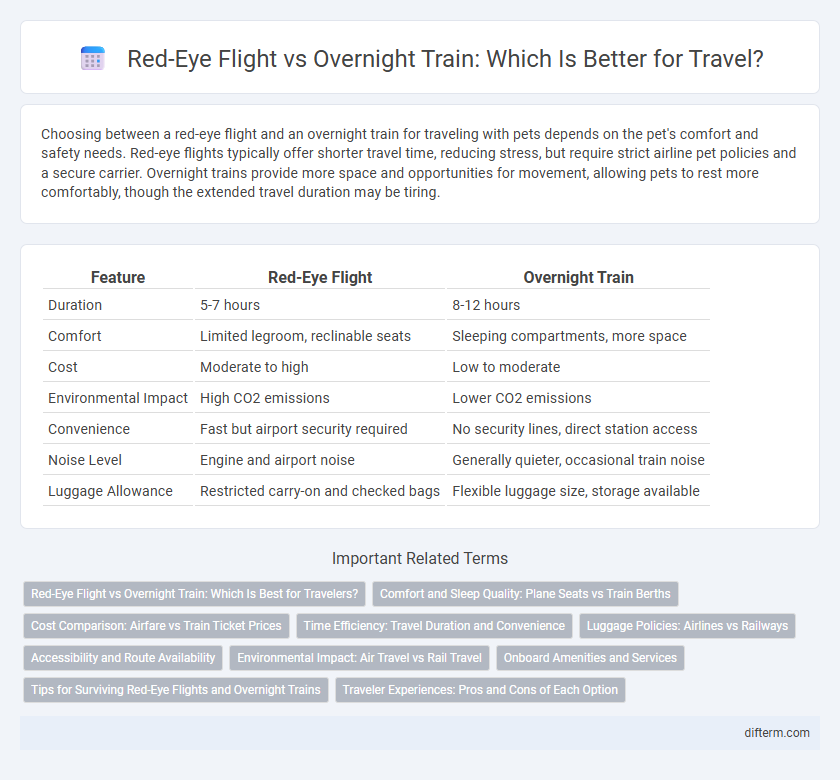Choosing between a red-eye flight and an overnight train for traveling with pets depends on the pet's comfort and safety needs. Red-eye flights typically offer shorter travel time, reducing stress, but require strict airline pet policies and a secure carrier. Overnight trains provide more space and opportunities for movement, allowing pets to rest more comfortably, though the extended travel duration may be tiring.
Table of Comparison
| Feature | Red-Eye Flight | Overnight Train |
|---|---|---|
| Duration | 5-7 hours | 8-12 hours |
| Comfort | Limited legroom, reclinable seats | Sleeping compartments, more space |
| Cost | Moderate to high | Low to moderate |
| Environmental Impact | High CO2 emissions | Lower CO2 emissions |
| Convenience | Fast but airport security required | No security lines, direct station access |
| Noise Level | Engine and airport noise | Generally quieter, occasional train noise |
| Luggage Allowance | Restricted carry-on and checked bags | Flexible luggage size, storage available |
Red-Eye Flight vs Overnight Train: Which Is Best for Travelers?
Red-eye flights offer faster travel times and the convenience of arriving early at your destination, ideal for business travelers and tight schedules. Overnight trains provide spacious seating, the ability to move around freely, and scenic views, appealing to those seeking comfort and a unique travel experience. Choosing between red-eye flights and overnight trains depends on priorities like speed, cost, comfort, and the desire for a restful journey.
Comfort and Sleep Quality: Plane Seats vs Train Berths
Red-eye flights often feature cramped airplane seats that limit recline and legroom, frequently leading to disrupted sleep and discomfort during the journey. Conversely, overnight trains provide dedicated berths or sleeper cabins, allowing passengers to lie flat and enjoy a more restful, uninterrupted sleep experience. Train berths typically promote better sleep quality through increased space and privacy, making them a preferable choice for travelers prioritizing comfort on overnight trips.
Cost Comparison: Airfare vs Train Ticket Prices
Red-eye flights generally offer lower airfare compared to daytime flights but can still be more expensive than overnight train tickets, which often provide budget-friendly options for long-distance travel. Train ticket prices fluctuate based on class and route but tend to be more economical due to fewer fees and simpler booking processes. Travelers should weigh the specific costs, including potential baggage fees and convenience, when comparing red-eye flight prices with overnight train fares.
Time Efficiency: Travel Duration and Convenience
Red-eye flights typically offer faster travel durations, often covering long distances within 5 to 7 hours, maximizing overnight travel efficiency compared to overnight trains, which can take 8 to 12 hours or more. Trains provide more spacious seating and allow passengers to move freely, but the convenience of arriving at the destination early morning with minimal transit time often favors red-eye flights for business travelers and time-sensitive trips. Choosing between the two depends on prioritizing speed and direct routes versus comfort and onboard amenities during overnight travel.
Luggage Policies: Airlines vs Railways
Red-eye flights typically allow passengers to bring one carry-on bag and one personal item with strict size and weight limits, while checked baggage often incurs additional fees depending on the airline. Overnight trains generally offer more generous luggage policies, permitting larger and multiple bags without extra charges, and provide easier access to luggage during the journey. Travelers should compare specific airline and railway companies' regulations to optimize packing strategies and avoid unexpected fees.
Accessibility and Route Availability
Red-eye flights offer extensive accessibility with numerous domestic and international routes connecting major hubs, making them ideal for travelers seeking speed and convenience. Overnight trains provide more limited route availability, often restricted to specific corridors or regions, but excel in offering direct city-center arrivals without airport transfers. The choice depends on balancing the frequency and reach of red-eye flights against the localized, often scenic routes accessible by overnight trains.
Environmental Impact: Air Travel vs Rail Travel
Red-eye flights emit significantly higher greenhouse gases per passenger mile compared to overnight trains, contributing more to climate change due to jet fuel combustion. Rail travel relies primarily on electricity, often sourced from renewable energy, resulting in substantially lower carbon emissions and reduced air pollution. Choosing overnight trains over red-eye flights supports sustainable travel by minimizing environmental impact and conserving energy resources.
Onboard Amenities and Services
Red-eye flights often provide limited onboard amenities such as basic meal service, in-flight entertainment, and recliner seats, prioritizing quick transit over comfort. Overnight trains offer spacious sleeping cabins, dining cars with full-service meals, and lounge areas designed for relaxation and socializing, enhancing the travel experience. Passengers seeking comfort and convenience may prefer overnight trains, while those prioritizing speed choose red-eye flights despite fewer amenities.
Tips for Surviving Red-Eye Flights and Overnight Trains
To survive red-eye flights, choose window seats to lean against for better sleep, wear comfortable clothing, and bring noise-canceling headphones to block out ambient noise. For overnight trains, pack a travel pillow and blanket, secure your belongings in a locked compartment, and use earplugs to minimize noise disruptions. Staying hydrated and avoiding caffeine before departure are essential strategies for both modes of overnight travel.
Traveler Experiences: Pros and Cons of Each Option
Red-eye flights offer the advantage of quick travel with minimal transit time, ideal for maximizing daytime activities but often involve cramped seating and disrupted sleep quality. Overnight trains provide spacious seating or sleeper cabins, allowing more comfortable rest and scenic night views, yet they tend to take longer and may lack the speed efficiency of air travel. Travelers prioritize red-eye flights for speed and convenience, while overnight trains are favored for comfort and the experience of leisurely travel.
red-eye flight vs overnight train Infographic

 difterm.com
difterm.com